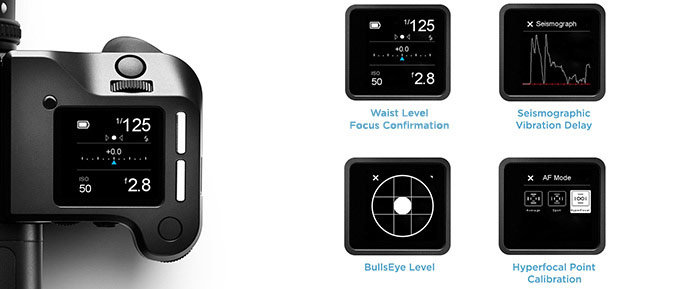Phase One
New Phase One XF Firmware
The Perspective of Phase One VP Of R+D Lau Nørgaard
Our Perspective
When the XF launched we made a big deal about not just how great its feature set and capabilities were at launch, but how it had been designed to be an extensible field-upgradeable flagship platform for years to come – a stark contrast to the nearly disposable mentality many camera companies have.
With this first firmware update, released just fours months after the XF shipped, Phase One is showing that this commitment to the XF platform is real. This is just a taste; many great ideas are floating around Phase One’s R+D center in Copenhagen. Do you have an idea for a tool or feature for the XF or an integration with Capture One that you feel would add to the XF’s professional toolkit? Please email info@digitaltransitions.comand we’ll pitch your idea directly to the head of R+D. Phase One has a very flat hierarchy and as the largest Phase One dealer in the world we are honored to be frequently consulted on what users are asking for.
Features
Copyright Embedding: A little referenced feature, even in Phase One’s own press release, is one of our favorite. In the new firmware you can add copyright information into the IIQ raw files the back records. Nothing stops you from also using this function to enter additional (short) metadata which would then be searchable in Capture One.
WLF Focus Confirmation: When using a standard 90° Viewfinder focus confirmation appears in the bottom left of the viewfinder readout. When using autofocus this confirms the AF engine successfully locked on to the subject, and when manually focusing it provides you a [ > ] or [ < ] or [ O ] symbol to indicate if you are focused too closely, too distantly, or correctly. With the new XF firmware a focus confirmation is now shown on the top “OneTouch” LCD when using a Waist Level Viewfinder.
Hyperfocal Point Calibration: This feature was introduced with the first firmware of the XF but did not work especially well (see: Stability and Bug Fixes below). Now it works and it is awesome. It can be used (as it’s name suggests) for precise, repeatable, easily accessible hyperfocal focusing. It can also be used to save and recall a specific focus distances in other shooting scenarios. For instance a street shooter could set a 10ft focus distance to the rear button, manually focus for some period of time, and then snap the focus to 10 ft instantly at any point (even without looking at the camera).
Seismograph Based Vibration Mode: In the initial XF firmware there was a capture mode called “Vibration” mode. There was also a way to view ambient vibration in the Seismograph Tool. In the new firmware these two functionalities are now linked together. By turning on [Menu > Capture Setup > Vibr. Detect] the camera will wait until vibration (caused by e.g. your hand, the mirror, a passing car etc) has ceased. The maximum amount of time the body will wait depends on the setting selected under [Vibr. Delay]. When using a lighter weight tripod for instance the body may need to wait several seconds after the mirror is put up, while on a heavy camera stand it may trigger after just a second or two.
Remote Focusing: The new firmware enables remote focusing from Capture One. This provides extraordinary control for still life, product, and cultural heritage shooters. This capability extends the full camera control already available for the XF through Capture One. In addition to basic control like initiating a capture, changing shutter speed or aperture, and putting the mirror up the user can also take advantage of advanced controls like changing custom button assignments, the duration of the self timer, and any other custom setting on the body.
Bullseye: The new firmware provides a real-time level so the user can adjust the camera to be perfectly level when their most comfortable view is from above the body. This extends the option to show a 2-axis level (graphically or numerically) on the rear LCD of a Phase One IQ, IQ2, or IQ3 back.
Histogram: The top OneTouch LCD now display a histogram after a captured image.
Stability and Bug Fixes
Anytime an entirely new body is released there are a few quirks. When the XF was first launched we held our breath until we had a chance to extensively and independently tested it. We were pleasantly surprised at how few bugs we found; it’s core performance was rock solid even when pushed hard (put in freezer, shot in hot sun, shooting continously for extended periods etc). That said, there were a few quirks in some of the peripheral features. Specifically the hyperfocal function was not stable, behavior with fully manual lenses (like in our Big Buttery Bokeh series) was buggy, and on rare instances changing the ISO would lock up the camera. Phase One was very responsive to our reports of these issues and in our testing of the new firmware these quirks have been fully addressed.
Further Testing
We’ll be testing this new firmware more in the coming weeks. It was only recently finalized. As with any software or firmware update we strongly advise against upgrading if you are in the middle of or about to start a job or production; any such update carries a small-but-non-zero risk.
Ready to Install?
Instructions for installing the firmware and more details about the features it enables can be found at the same link in the release notes.
Try The New Firmware in Person
We will have the new firmware loaded on our XF Bodies at the upcoming Photo Plus Expo and our 12 Year Anniversary Party.

